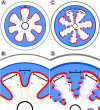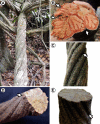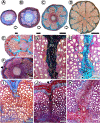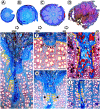Phloem wedges in Malpighiaceae: origin, structure, diversification, and systematic relevance
- PMID: 35484568
- PMCID: PMC9052467
- DOI: 10.1186/s13227-022-00196-3
Phloem wedges in Malpighiaceae: origin, structure, diversification, and systematic relevance
Abstract
Background: Phloem wedges furrowing the wood are one of the most notorious, widespread types of cambial variants in Angiosperms. Many lianas in Malpighiaceae show these variations in the arrangement of the secondary tissues. Here we explore their ontogeny, structure, and evolution in Malpighiaceae, where phloem wedges appeared multiple times, showing how they have contributed to the anatomical diversification of the family. Using a broad sampling with 143 species from 50 genera, covering all major lineages in Malpighiaceae, we crossed data from ontogeny, stem anatomy, and phylogenetic comparative methods to determine ontogenetic trajectories, final anatomical architectures, and evolution within the most recent phylogeny for the family.
Results: Phloem wedges appeared exclusively in lianas and disappeared in shrub lineages nested within liana lineages. At the onset of development, the vascular cambium is regular, producing secondary tissues homogeneously across its girth, but soon, portions of the cambium in between the leaf insertions switch their activity producing less wood and more phloem, initially generating phloem arcs, which progress into phloem wedges. In the formation of these wedges, two ontogenetic trajectories were found, one that maintains the continuity of the cambium, and another where the cambium gets dissected. Phloem wedges frequently remain as the main cambial variant in several lineages, while in others there are additional steps toward more complex cambial variants, such as fissured stems, or included phloem wedges, the latter a novel type of interxylary phloem first described for the family.
Conclusions: Phloem wedges evolved exclusively in lianas, with two different ontogenies explaining the 10 independent origins of phloem wedges in Malpighiaceae. The presence of phloem wedges has favored the evolution of even more complex cambial variants such as fissured stems and interxylary phloem.
Keywords: Cambial variant; Discontinuous cambium; Lianas; Limiting rays; Malpighiaceae; Phloem; Phloem wedges; Vascular cambium; Xylem.
© 2022. The Author(s).
Conflict of interest statement
The authors declare that they have no competing interests.
Figures








References
-
- Gentry AH. The distribution and evolution of climbing plants. In: Putz FE, Mooney HA, editors. The biology of vines. New York: Cambridge University Press; 1991. pp. 3–49.
-
- Ibarra-Manríquez G, Rendón-Sandoval FJ, Cornejo-Tenorio G, Carrillo-Reyes P. Lianas of Mexico. Bot Sci. 2015;93(3):365–417. doi: 10.17129/botsci.123. - DOI
-
- Anderson C, Anderson WR, Davis CC: Malpighiaceae. 2006. https://webapps.lsa.umich.edu/herbarium/malpigh/. Accessed 05 Jul 2021.
Grants and funding
LinkOut - more resources
Full Text Sources

